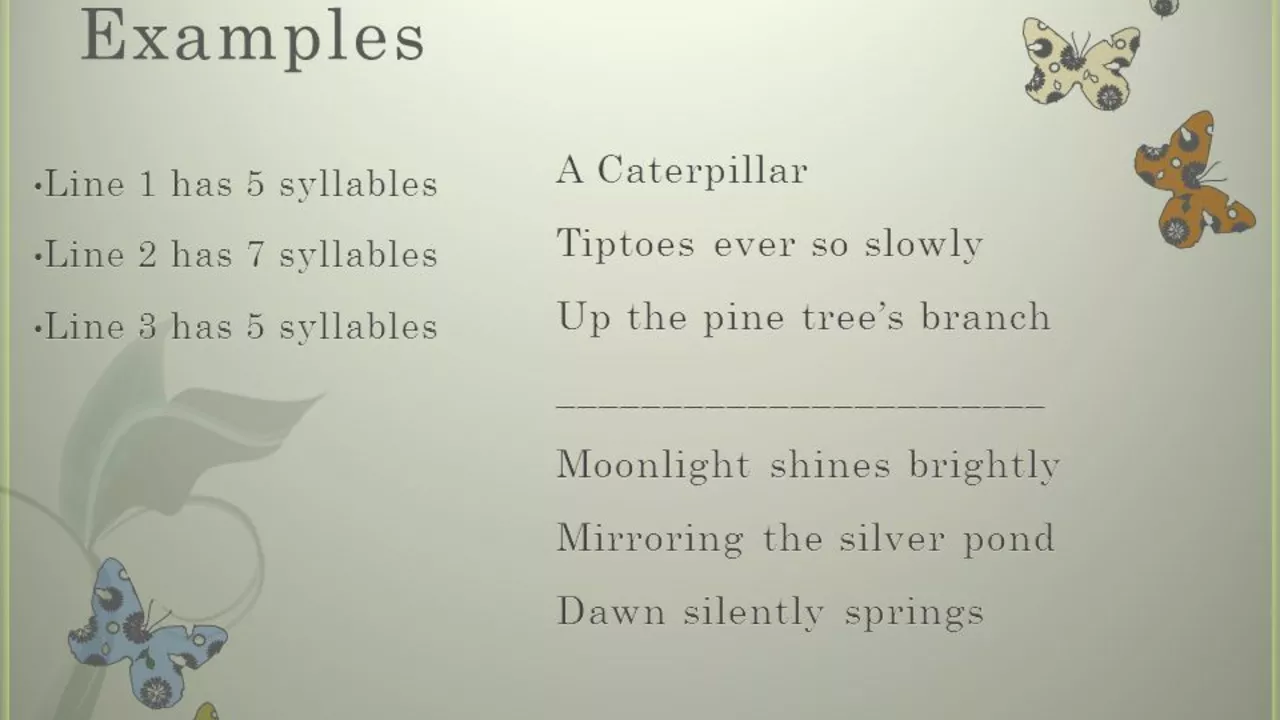Unveiling the Mystery: Haiku & Its Singularity
So you're inquisitive about poetry, huh? Good for you! It's a compelling realm, brimming with sentiment and picturesque imagery. The array of poetry styles is vast, each one catering to a particular aura or sentiment. Among them all, though, is one sleeping giant with a simple yet enigmatic disposition: Haiku. Now, Haiku is a tricky monkey. It doesn't hold the same grand stature that a sonnet does, nor does it echo the hypnotic rhythms of traditional rhyme schemes. Yet, it fascinates poets and enthusiasts alike with its encapsulating intricacy packed into a compact structure.
Origin & Evolution: Haiku through the Ages
The haiku we all know and scribble on napkins these days originally derived from a humble Japanese poetry form known as a hokku. This form was typically a part of a linked-verse poem. At some point, savvy poets decided that these compact lines had the potential to breathe their own air, et voilà! The haiku, as we know it today, was born. Now, what differentiates haiku from other poetic forms isn't just its origins but the subsequent adaptation and evolution it underwent. It's been shaped by diverse cultures and languages over time. Elias can't help but relish the reminder of sitting in a literary history course back in school, dissecting poetry forms with the eagerness of a young scholar.
Cracking the Three-Line Code: Syntax of Haiku
The haiku is a tiny titan, three lines with an astonishing weight. Its structure typically entails three lines, with a 5-7-5 syllable count. That's right, the entire poem consists of just 17 syllables! Compare this with other poetic forms, from the sprawling free verse to intricate sonnets, and the divergence is clear. It's akin to crafting micro stories. Developing a strong, compelling thematic element in such a compact format requires real mental agility. By compressing such immense feelings and settings into a structured, concise context, haiku forces us to think outside the box, challenging our creative prowess.
Savoring the Moment: Temporality in Haiku
One of the unique traits of haiku is its encapsulation of a moment. It's not about lengthy contemplation or thorough exposition. Instead, it focuses on the senses, painting a vivid moment caught in a snippet of space and time. In contrast, lyrical poetry, such as ballads and sonnets, often dwell on recurring themes, traveling across time fragments. On the other hand, haiku is a slice of life, a snapshot, a brief encounter with reality. Elias remembers an incident from his childhood when he found an abandoned nest in his parents' garden. Fascinated, he wrote his first Haiku capturing his raw feelings at that moment.
Haiku vs Free Verse: The Battle of Constraints
In comparison to free verse, haiku may seem confined. Free verse, in essence, is poetry without a definite structure or rhyme scheme, leaving the poet to shape the poem as it evolves naturally. Now, you may think, "Hey, Elias, doesn't that mean free verse is more, you know, free?" This compels us to look at creativity from a new perspective. Sometimes, as paradoxical as it sounds, constraints actually inspire creativity. The magic unfolds when one tries to express eloquently within those set boundaries. This is exactly why haiku manages to create imagery as pronounced as a well-crafted long-form poem.
Reality Check: Fact & Fiction in Haiku
Unlike its poetic counterparts that may dive deeply into abstract or fantastical realms, haiku tend to grip the essence of reality. Haikus thrive on concrete imagery and sensory experiences. They are built around perceptions and observations, tethered to the natural world and human existence. This rootedness in reality marks a significant departure from the common realms of poetry, presenting a refreshing shift in perspective for poetic exploration. Elias, at one point, used to believe that poetry was all about escapism, until the subtlety of haiku taught him the beauty of embracing reality.
Voila! The Punchline: Kireji in Haiku
Last, but not least, we have kireji — cutting or pivot words, the secret powerhouse behind the haiku! Kireji are deployed in the traditional Japanese haikus to add structural support, dividing the poem into two contrasting or ironically juxtaposed parts. It's like the punchline that brings the whole scene into sharp focus. Wham! The minimalistic structure amplifies the impact, creating a lasting impression, something you can't find in long and winding verses. Love it or hate it, this punchy dynamism sets haiku apart from the cosmic gravy of other poetic forms!
Discovering the Haiku: A Journey Worth Taking
All in all, the haiku is a unique beast when contrasted with other forms of poetry. Its structure is concise yet intricate, requiring a fine balance between lush imagery and succinct expression. It's much like a perfectly brewed espresso – short, strong, and memorable! The difference between a haiku and other forms of poetry is not merely a matter of counting syllables or lining up rhymes; it’s a philosophical journey, a fresh way of perceiving the world. The haiku is a testament to the power of less truly being more. So, if you're an aspiring poet or simply someone who enjoys the magic of words, exploring the intriguing landscape of haiku would be a journey worth embarking on.

Elias Whitestone
Hello, I'm Elias Whitestone, an expert in the field of education with a passion for writing about poetry and learning experiences. I strive to inspire others through my own creative expression and innovative teaching methods. Having spent years honing my craft, I understand the impact that literature and education can have on individuals and society as a whole. My goal is to help others unlock their potential and foster a love for learning and artistic exploration.
view all postsWrite a comment